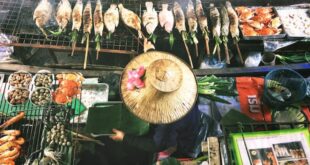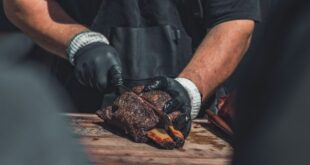Last Updated on October 16, 2023
For foodies seeking a novel culinary adventure, raw honey tasting in exotic locales offers a sensory journey like no other. As the popularity of raw, unprocessed honey grows, destinations across the globe now cater to honey enthusiasts eager to experience the nectar in its purest form. Grab your passports and get ready to discover raw honey wonders from some of the world’s most captivating regions.
Exploring Exotic Destinations for Raw Honey Tasting
Savor Mediterranean Honey Delights
The Mediterranean climate and diverse flora produce a wide spectrum of distinctive honeys for foodies to savor.
Greece, Italy, and Spain – Together these countries supply over 40% of Europe’s raw honey, with centuries-old beekeeping traditions. Greece is known for thyme and orange blossom honey, while Italy produces sweet chestnut, acacia, and wildflower honey. In Spain, look for rosemary, lavender, and wildflower varieties.
300+ floral varieties – Mediterranean honey showcases over 300 types of indigenous flora as ingredients. Citrus blossoms, wild thyme, eucalyptus trees, French lavender, Tuscan sunflower, Cretan oregano, and Spanish heather all contribute unique flavors.
Farms and cooperatives – Many beekeeping farms and honey cooperatives welcome visitors to observe traditional techniques. See demonstrations of artisanal production methods handed down through generations.
Food Pairings – Raw honey from this region perfectly accompanies cheese, yogurt, nuts, and, of course, Greek baklava. Pair thyme honey with goat cheese, lavender honey with ricotta, and orange blossom honey with Greek-style yogurt. For baklava, use regional wildflower or chestnut honey.
Sustainable Tourism – Opt for eco-conscious tour operators and providers that support ethical, community-based beekeeping across the Mediterranean. This ensures the environmental and economic sustainability of these treasured honey destinations.
Canada’s Natural Honey Treasures
Canada honey is indeed celebrated for its exceptional qualities, which are a testament to the country’s rich and diverse floral sources and its pristine natural landscapes. From the wildflowers of the Rockies to the clover fields of the prairies, Canadian honey embodies the unique and varied flavors and aromas of its surroundings.
While the majority of Canadian honey is amber or golden in color, it’s important to note that the country also boasts the exquisite variety known as white honey. White honey shares its origins with the diverse floral sources of Canada, but it is distinct in its own right.
Health Benefits – Like other types of honey, white honey in Canada contains a range of health-promoting properties. It is a natural source of nutrients, including vitamins, minerals, and antioxidants. Additionally, honey possesses natural antibacterial properties and has been used for its potential health benefits in traditional medicine.
Sought-After for Culinary Uses – White honey has become a coveted ingredient among chefs and home cooks alike. Its subtle sweetness and silky texture lend themselves beautifully to drinks, yogurt, baked goods, dressings, sauces – you name it.
Unlike traditional honeys, the delicate flavor of white honey lets other ingredients shine through while still adding a touch of sweetness. It’s an elegant way to enhance all kinds of foods and beverages.
Creamy Allure of White Honey – White honey’s lush, spreadable texture sets it apart from traditional honeys. With less moisture content, it takes on a lush, creamy consistency reminiscent of butter or clotted cream. This makes white honey a delightful topping for scones, biscuits, or crispy toast in the morning.
Its silky texture also shines when drizzled over ice cream, pancakes, fresh fruit, or panna cotta. White honey’s versatility lends itself to creative culinary uses. Pastry chefs in particular appreciate its velvety texture that doesn’t seep into delicate cakes or pastries.
Its creamy richness provides balance alongside tart fruits, bittersweet chocolate, or tangy cheeses. Whether used as a spread, sauce, or drizzle, white honey’s smooth, creamy texture elevates all kinds of sweet and savory treats.
Unique and Rare – You won’t find white honey sitting on every grocery store shelf. It’s still a relatively rare find compared to mass-produced clover or wildflower honeys. This scarcity only increases white honey’s appeal to gourmands and honey aficionados looking for something unique and special.
When you want to add a touch of sophistication to your cooking or mixology, white honey fits the bill. Its distinctive clarity and smoothness simply can’t be duplicated by ordinary honeys. Tracking down this elusive ingredient is part of the fun for many culinary pros and hobbyists.
Himalayan Honey Heights
The remote Himalayan valleys nurture special honey varieties with purported health benefits for adventurous foodies.
Rare Varieties – Explore unique honey-like Rhododendron honey with its reddish hue and slightly tart flavor, as well as the highly-prized honey from ancient Himalayan Sidr trees. Himalayan forest honey offers intense herbal nuances from high-altitude flora.
Beekeeping Tours – Trek to remote Himalayan apiaries to see traditional beekeeping first-hand. Interact with indigenous beekeepers and understand how they practice sustainable harvesting within the fragile mountain ecology.
Flavor Complexity – The pristine high-altitude environment makes Himalayan honey intensely and intricately flavored. Experience notes like spice, smoke, and dried fruit. The long winters concentrate nectar content and aromatics.
History -Honey has a long history. Beekeeping took hold during the colonial era as pioneers brought European honey bees and cultivated them for food and wax. Today, honey remains an important agricultural commodity, with over 200,000 American beekeepers managing colonies for honey production and pollination services.
Conservation Challenges – Climate change, deforestation, and overharvesting threaten Himalayan honey production. Support initiatives by local groups like the Himalayan Beekeeper Society to protect these treasures.
African Raw Honey Wilderness
Africa’s diverse landscapes yield a wide variety of raw honey flavors and types.
10% of global supply – Africa produces over 500,000 tonnes annually, with varying flavors based on region.
Cultural significance – Honey holds an important place in African rituals, folklore, and traditional medicine.
Beekeeping safaris – Go on a guided beekeeping safari to learn hands-on honey hunting and production.
Pair with tea – Raw honey from regions like the Tanzanian hinterlands goes wonderfully with African herbal teas.
Master Raw Honey Tasting Techniques
Learn how to properly taste raw honey with these techniques:
Sensory evaluation – Assess honey’s aroma, flavor, texture, and color. Let it linger on the tongue to experience subtle notes.
Impact of terroir – Like wine, honey’s characteristics come from its botanical origin and environment. Familiarize yourself with key terroirs.
Step-by-step guide – Follow a structured tasting methodology to optimize your honey analysis. From inspection to in-mouth sensations, a guided approach ensures you fully experience the honey.
Food Pairings That Make Honey Shine
Complement raw honey’s nuances by pairing it with compatible foods:
300+ types of cheese – Raw honey pairs remarkably well with cheese. Experiment with different cheese textures, milk types, and honey flavors.
Fruits and nuts – The natural sweetness of fruits accentuates honey’s flavor. Also, try honey drizzled over warm baklava stuffed with nuts and phyllo dough.
Dessert recipes – Use raw honey to make decadent treats like honeycomb candy, baklava, and honey ice cream. The honey adds depth and keeps desserts moist.
Storing Liquid Gold: Raw Honey Preservation Tips
Learn proper techniques to store raw honey and prevent crystallization:
Indefinite shelf life – Kept in air-tight containers in a cool, dry place, raw honey stays fresh indefinitely, just like the edible honey found in ancient Egyptian tombs.
Crystallization – This natural process does not affect honey’s quality. Gently warm crystallized honey to return it to liquid form.
Bottling – Opt for small batches in dark glass bottles to maintain quality. Always use clean, sterile equipment.
Air exposure – Limit air contact, which evaporates aromatic compounds and alters honey’s flavor over time. Dispense honey with clean utensils.
Final Thoughts
The incredible diversity of raw honey across the world offers endless opportunities for culinary explorers and honey aficionados. As your taste buds delightfully discover, each honey carries the essence of its regional terroir – the climate, soil, flora, and traditions that make it special.
Beyond visceral pleasures, responsible honey tourism also allows conscious foodies and eco-travelers to support sustainable beekeeping communities. From the small-batch honey of the Mediterranean basin to Nepal’s remote mountain hives, a tasting adventure of sustainable raw honey awaits. Let your curiosity guide you to savor nature’s golden nectar, wherever your palate dares to wander!
Discover a World of Honey Flavors
The diversity of raw honey across the globe provides endless opportunities for culinary exploration. As your palate delightfully discovers, raw honey offers far more than just sweetness – it tells the sensory story of lands near and far. From Mediterranean delights to African wilderness, a tasting adventure awaits. Savor nature’s golden nectar in all its glory!
Frequently Asked Questions
Is raw honey safe to eat and does it have health benefits?
Yes, raw honey that is naturally processed is completely safe for consumption. It contains antioxidants and enzymes linked to various health benefits like improved immunity, wound healing, and digestive health.
How does location affect honey’s taste?
Terroir or location affects honey’s flavor based on the native vegetation, climate, and environment of the bees’ habitat. Each distinctive bio-region yields unique-tasting honey. This concept is similar to how geography impacts the flavor of wine.
 Travel for Food Hub The Food Blog for Travel Lovers
Travel for Food Hub The Food Blog for Travel Lovers
















